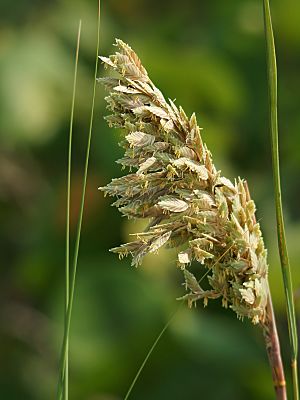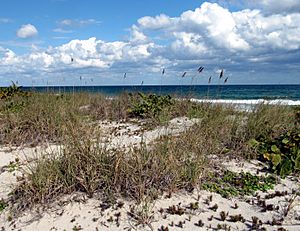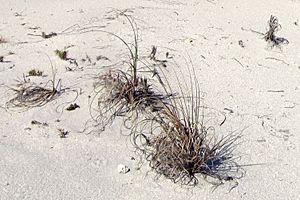Sea oats facts for kids
Quick facts for kids Sea oats |
|
|---|---|
 |
|
| Scientific classification | |
| Genus: |
Uniola
|
| Species: |
paniculata
|
Sea oats (scientific name: Uniola paniculata) are tall, special grasses. They grow in warm, sunny places like beaches and sand dunes. You can find them in the southeastern United States, eastern Mexico, and some Caribbean islands.
Sea oats get their name from their large seed heads. These turn a golden brown color in late summer, looking a bit like oats. This amazing plant helps protect our beaches and homes from strong winds and storms. It also provides food and a home for many birds, small animals, and insects.
Contents
What are Sea Oats?
Sea oats are tall grasses that can grow up to 3 to 6 feet (1 to 2 meters) high. Their long, thin leaves are about 8 to 16 inches (20 to 40 cm) long. They are also only about 0.2 inches (0.6 cm) wide, with a pointy tip.
In late summer, the plant grows clusters of flat seed pods. Each pod holds 10 to 12 tiny flowers. The wind helps spread the pollen from these flowers. When the seeds are ready, they turn a golden brown color. The wind can carry these seeds far away, even across the ocean! But sea oats also spread easily by growing new shoots from their roots.
This plant has two types of roots. Some roots grow close to the surface, and others dig deep into the sand. These roots work with helpful fungi in the soil. Sea oats also have special underground stems called rhizomes. These rhizomes spread out and can grow new roots and shoots when covered by sand. This helps the plant spread and hold the sand in place.
Where Sea Oats Live
Sea oats grow on beaches and barrier islands. You can find them along the Atlantic Coast from New Jersey down to Florida. They also grow along the Gulf Coast from Florida to Tabasco, Mexico. You can also see them in the Bahamas and northwestern Cuba.
These plants mostly grow on the front dunes and at the top of the dunes. They don't usually grow in the low, wet areas between dunes. This is because they need a lot of salt spray from the ocean. You will rarely find sea oats growing far away from the coast.
How Sea Oats Grow
Sea oats grow in very tough conditions. This means they don't have many other plants competing with them. They can handle hot weather and don't need much water. They are also very good at dealing with salty water and short floods from the sea.
These plants love loose sand. They do not grow well in muddy or clay-rich soils. They also don't like to be waterlogged. Sea oats are amazing because they help build sand dunes! As the wind blows sand, the sea oats trap it. When the base of the plant gets covered by sand, it actually helps the plant grow more and spread its roots.
However, human activities can harm sea oats. Things like pollution from cities and boats can hurt them. Also, driving off-road vehicles or walking too much on the dunes can damage the plants. This can break their roots and pack down the sand. When sea oats are damaged, the sand dunes can wash away easily. This leads to more beach erosion.
Why Sea Oats are Important
Sea oats are very important for beach environments. They are often used in projects to stabilize sand dunes. Their long, strong roots hold the loose sand firmly in place. For example, in Fort Lauderdale, Florida, many sea oats have been planted on beaches. They are a key part of the area's plan to protect against hurricanes and tropical storms. These sea oat colonies are expected to grow and help protect the coast.
Legal Protection
Because they are so important, sea oats are protected by law in several states. In Georgia, South Carolina, and North Carolina, it is against the law to pick or disturb sea oats. If you do, you could get a fine. Florida also has laws that protect sea oats and the people who grow them in nurseries.
Wildlife Habitat
The seeds of sea oats are a food source for many animals. Birds like red-winged blackbirds and sparrows eat them. Small animals like marsh rabbits and mice also enjoy the seeds. In Florida, scientists have found that pygmy burrowing owls build their nests among sea oat plants. This helps them hide their young from predators like frigatebirds.
Images for kids




